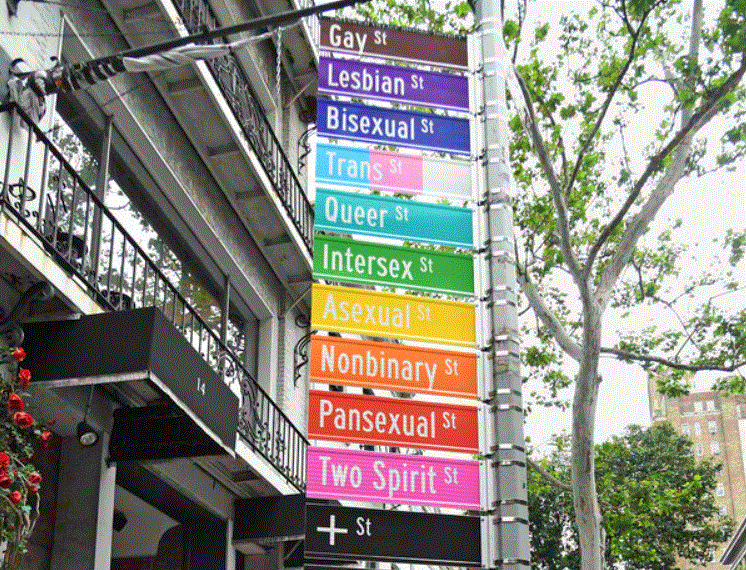Main Body
Module 6 How Does Gender Affect Sexual Behavior?
Sexual Orientation
Sexuality is defined in many ways including the capacity for sexual responses and experiences (Bosson et al. 2019) and a general term for the feelings and behaviors of humans concerning sex (Carroll, 2016). Sexual Orientation refers to the direction of emotional and erotic attraction toward a particular gender. It is a personal quality that inclines people to feel romantic or sexual attraction (or a combination of these) to persons of a given sex or gender. According to the American Psychological Association (APA) (2016), sexual orientation also refers to a person’s sense of identity based on those attractions, related behaviors, and membership in a community of others who share those attractions. Sexual orientation is independent of gender; for example, a transgender person may identify as heterosexual, homosexual, bisexual, pansexual, polysexual, asexual, or any other kind of sexuality, just like a cisgender person.
Sexual orientation labels:
- Queer signifies a range of different sexual orientations and gender behaviors, identities, or ideologies.
- Gay refers to men who are sexually attracted to other men.
- Lesbian refers to women who are sexually attracted to other women.
- Bisexual was a term traditionally used to signify being sexually attracted to both men and women, but it has recently been used in nonbinary models of sex and gender to refer to attraction to any sex or gender.
- Polysexual is an alternative term to bisexual that signifies being sexually attracted to people of many sexes and gender identity.
- Pansexual is an alternative to the term to bisexual that refers to being sexually attracted to all sexes and gender identities.
- Heterosexual, which is often referred to as being straight, indicates that the individual is sexually attracted to the other sex.
- Asexual signifies little desire or sexual associations.
Sexual Orientation on a Continuum:
Sexuality researcher Alfred Kinsey was among the first to conceptualize sexuality as a continuum rather than a strict dichotomy of gay or straight. To classify this continuum of heterosexuality and homosexuality, Kinsey et al. (1948) created a seven-point rating scale that ranged from exclusively heterosexual to exclusively homosexual. Research done over several decades has supported this idea that sexual orientation ranges along a continuum, from exclusive attraction to the opposite sex/gender to exclusive attraction to the same sex/gender (Carroll, 2016).
Development of Sexual Orientation
In reviewing the origins of sexual orientation, research has focused on same-sex orientations. According to Farvid (2015), “Historically, heterosexuality has largely been ignored in psychological theory and research as a topic of, or for, analysis. Psychological theory has assumed that heterosexuality is a ‘given’ and ‘normal’, and focused its research on sexualities that sit outside this supposed norm (e.g. homosexuality, lesbianism). Such research has functioned to further normalize heterosexuality, while pathologizing other ways of being sexual, without taking into account the historical conditions that have produced heterosexuality as the norm” (p. 92). Consequently, theories have attempted to explain the sexual orientation of LGBTQ individuals rather than opposite sex orientations.
According to current scientific understanding, individuals are usually aware of their sexual orientation between middle childhood and early adolescence (APA, 2016). However, this is not always the case, and some do not become aware of their sexual orientation until much later in life. It is not necessary to participate in sexual activity to be aware of these emotional, romantic, and physical attractions; people can be celibate and still recognize their sexual orientation. Some researchers argue that sexual orientation is not static and inborn but is instead fluid and changeable throughout the lifespan.
There is no scientific consensus regarding the exact reasons why an individual holds a particular sexual orientation. Research has examined possible biological, developmental, social, and cultural influences on sexual orientation, but there has been no evidence that links sexual orientation to only one factor (APA, 2016). However, biological explanations, that include genetics, birth order, and hormones will be explored further as many scientists support biological processes occurring during the embryonic and and early postnatal life as playing the main role in sexual orientation (Balthazart, 2018).
Genetics:
Using both twin and familial studies, heredity provides one biological explanation for same-sex orientation. Bailey and Pillard (1991) studied pairs of male twins and found that the concordance rate for identical twins was 52%, while the rate for fraternal twins was only 22%. Bailey et al., (1993) studied female twins and found a similar difference with a concordance rate of 48% for identical twins and 16% for fraternal twins. Schwartz et al., (2010) found that gay men had more gay male relatives than straight men, and sisters of gay men were more likely to be lesbians than sisters of straight men.
Fraternal Birth Order:
The fraternal birth order effect indicates that the probability of a male identifying as gay increases for each older brother born to the same mother (Balthazart, 2018; Blanchard, 2001). According to Bogaret et al. “the increased incidence of homosexuality in males with older brothers results from a progressive immunization of the mother against a male specific cell-adhesion protein that plays a key role in cell-cell interactions, specifically in the process of synapse formation,” (as cited in Balthazart, 2018, p. 234). A meta-analysis indicated that the fraternal birth order effect explains the sexual orientation of between 15% and 29% of gay men.
Hormones:
Excess or deficient exposure to hormones during prenatal development has also been theorized as an explanation for sexual orientation. One-third of females exposed to abnormal amounts of prenatal androgens, a condition called congenital adrenal hyperplasia (CAH) described in module 3, identify as bisexual or lesbian (Cohen-Bendahan et al., 2005). In contrast, too little exposure to prenatal androgens may affect male sexual orientation by not masculinizing the male brain (Carlson, 2011).
Same Sex Discrimination:
The United States is heteronormative, meaning that society supports heterosexuality as the norm. Consider, for example, that homosexuals are often asked, “When did you know you were gay?” but heterosexuals are rarely asked, “When did you know you were straight?” (Ryle, 2011). Living in a culture that privileges heterosexuality has a significant impact on the ways in which non-heterosexual people are able to develop and express their sexuality.
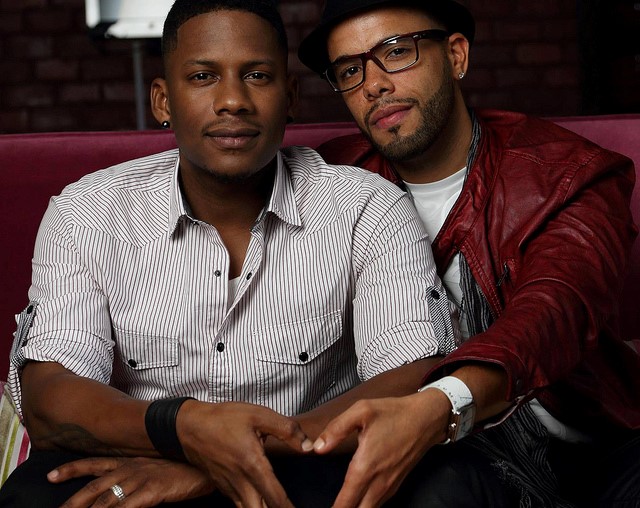
Open identification of one’s sexual orientation may be hindered by homophobia which encompasses a range of negative attitudes and feelings toward homosexuality or people who are identified or perceived as being lesbian, gay, bisexual, or transgender (LGBT). It can be expressed as antipathy, contempt, prejudice, aversion, or hatred; it may be based on irrational fear and is sometimes related to religious beliefs (Carroll, 2016). Homophobia is observable in critical and hostile behavior, such as discrimination and violence on the basis of sexual orientations that are non-heterosexual. Recognized types of homophobia include institutionalized homophobia, such as religious and state-sponsored homophobia, and internalized homophobia in which people with same-sex attractions internalize, or believe, society’s negative views and/or hatred of themselves.
Sexual minorities regularly experience stigma, harassment, discrimination, and violence based on their sexual orientation (Carroll, 2016). Research has shown that gay, lesbian, and bisexual teenagers are at a higher risk of depression and suicide due to exclusion from social groups, rejection from peers and family, and negative media portrayals of homosexuals (Bauermeister et al., 2010). Discrimination can occur in the workplace, in housing, at schools, and in numerous public settings. Much of this discrimination is based on stereotypes and misinformation. Major policies to prevent discrimination based on sexual orientation have only come into effect in the United States in the last few years.
The majority of empirical and clinical research on LGBT populations are done with largely white, middle-class, well-educated samples. This demographic limits our understanding of more marginalized populations that are also affected by racism, classism, and other forms of oppression. In the United States, non-Caucasian LGBT individuals may find themselves in a double minority, in which they are not fully accepted or understood by Caucasian LGBT communities and are also not accepted by their own ethnic group (Tye, 2006). Many people experience racism in the dominant LGBT community where racial stereotypes merge with gender stereotypes.
A Growing Acceptance:
According to a recently published PEW Research Center report (Poushter & Kent, 2020) there has been an increase in acceptance of same-sexuality, although it varies widely by region. In many nations this acceptance is also influenced by respondents’ age, level of education, religious affiliation, and to some degree gender. In general, older adults, those with less education, those affiliated with a religious group, and in nations where gender differences were found, men are less accepting. Right leaning political groups, both within the U.S. and Europe, are also less accepting.
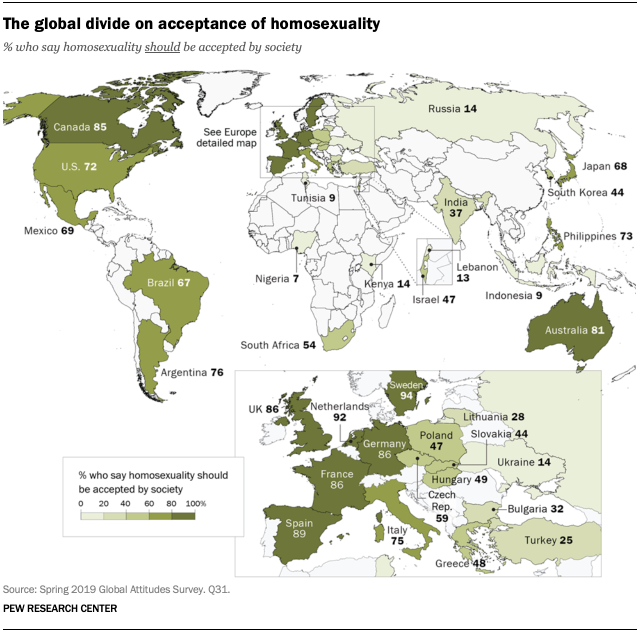
Attraction
Mate Preferences in Heterosexual Relationships:
According to evolutionary psychology’s sexual strategies theory (Buss & Schmitt, 1993), gender differences in mate preferences reflect the evolutionary roles of men and women. Specifically, men value a fertile partner, thus youthfulness as displayed in appearance and age would be highly sought after, while women seek a partner that offers greater stability, and thus can protect and provide for both her and her offspring (Buss & Bames, 1986). Is this still the case today? Bech-Sorenson and Pollet (2016) found that little had really changed. Heterosexual women and men were asked whether they would consider marrying someone who had certain characteristics. Consistent with the predictions of evolutionary psychology, even today, women seek a more mature male who has resources, while men seek a younger, more attractive mate. However, the researchers did discover that not everything had stayed the same. In contrast with earlier research, both men and women seemed less concerned about their mate having been married before, already having children, or being of a different religion or race. Overall, these gender differences in mate selection preferences are robust and occur across many nations (Gallant et al., 2011).
| Characteristic | Effect Size d value |
| Older by 5 or more years | -.74 (large) |
| Younger by 5 or more years | 1.02 (very large) |
| Had been married before | .08 (close to zero) |
| Already had children | -.17 (small) |
| Was not likely to hold a steady job | .80 (large) |
| Was of a different religion | -.05 (close to zero) |
| Was of a different race | .20 (small) |
| Would earn much less than you | .52 (moderate) |
| Would earn much more than you | -.55 (moderate) |
| Was not good looking | -.72 (large) |
| Had more education than you | -.47 (moderate) |
| Had less education than you | .34 (small) |
Those from a sociocultural perspective challenge the narrowness of evolutionary psychology’s theory of mate selection (Zentner & Eagly, 2015). They suggest that like all things psychological, both nature and nurture are at the heart of mate preferences, and that these preferences are often shaped by current environmental forces that sometimes reflect gender-differences, and sometimes reflect gender-similarities. From this approach, human mate preferences are driven by the opportunities and customs provided to people by the surrounding society. Where there is greater gender inequality, one might expect to find greater gender differences in mate preferences that follow traditional divisions of labor whereby males seek young fertile women and women seek a provider. As a culture reaches greater parity between the genders, however, traditional mate preferences may become less pronounced. According to cross-cultural studies reported by Zenter and Eagly, this generally is what is found. Similarly, the age gap in a preferred mate (males seeking a younger female, females seeking older males) has been declining, especially in nations with greater gender equality. For instance, in Turkey (a nation with less gender equality) males seek a female that is about 4 years younger, but in Iceland (a nation with the greatest gender equality) the difference is about 1 and half years. The changes reported by Bech-Sorenson and Pollet (2016) above also reflect cultural changes in attitudes regarding cross-racial and religious relationships.
A significant factor contributing to a culture’s gender parity, and thus marriage trends, is the increased educational attainment by women. In the United States, men with higher earnings and greater education have traditionally been more likely to marry. The recent increase in education and earnings by women are indicative of a woman’s increased likelihood of marrying. Couples are now more likely to demonstrate homogamy, that is, marriage between individuals who are similar on various indicators. Consequently, the tradition of hypergamy; that is, women “marrying up” in educational attainment, has been replaced by, homogamy; that is, women marrying someone with equal education, and even hypogamy; that is, women “marrying down” (Zentner & Eagly, 2015). Women are seen as providing valuable educational and financial resources to the marriage. In contrast, those who lack education and financial attributes are less likely to marry.
The research regarding gender parity and the greater educational attainment of women is a more recent explanation for the reasons why individuals marry. In the past, evolutionary theory was proposed as the primary explanation for marriage (or a partnership) between a man and woman. Evolutionary theory states that gender differences are due to certain behaviors being more adaptive to females compared to males based on evolutionary selection (Hyde, 2014). Two important concepts, sexual selection and parental investment, are facets of evolutionary theory that have implications for gender differences. Sexual selection refers to members of one gender (usually males) competing among themselves for mating access to the other gender (usually females). Also, those being competed for (usually females) having preferences for and actively choosing to mate with members of the opposite gender (usually males). Gender differences in physical aggression have been identified as being due to sexual selection. Parental investment refers to the amount of investment a parent makes that will increase the survival of the offspring. Human females invest significantly more than human males in the survival of the offspring to reproduction age, and thus allowing the parent’s genes to be passed on to future children. Females have fewer eggs to use and a long gestational and nursing period to ensure the offspring’s health and survival. The parental investment theory has been used to explain why males prefer a larger number of sexual partners as a way to produce more offspring, while females prefer less partners to ensure the long-term survival of fewer offspring (Hyde, 2014). Overall support for an evolutionary explanation for gender differences in sexuality and other behaviors has been mixed.
Mate Preferences in Sex and Gender Minorities:
Prior research (Bailey et al., 1997) has shown that gay men and lesbian women are similar to their heterosexual counterparts in terms of what they are seeking in both a dating and more long-term relationship partner. Similar to heterosexuals, attractiveness is more crucial in short-term relationships than in long-term partnerships. Gay men are also more likely to place importance on physical appearance in their partner, similar to heterosexual men. Lippa (2007) found that lesbians, like heterosexual women, emphasize personality and seek a mate who is kind, honest, and has a good sense of humor. What the research also finds is that like heterosexuals, gay men and lesbian women often seek someone who is sex-typical in appearance (Bailey et al., 1997; Lippa, 2007; Zhang, et al., 2019). Just as heterosexual males seek a feminine female, and heterosexual females seek a masculine male, gay men also seek a male partner who is typical in appearance for a male, and lesbian women seek a female partner who is typical in appearance for a female.
As reported elsewhere in the text, there is little research on transgender people, and the research on mate selection is no exception. However, as Aristegui et al. (2018) note this is surprising as studying transgender people offers an opportunity to assess whether biological gender or chosen gender has an impact of mate preferences. Aristegui and colleagues examined the mate selection preferences of transgender adults in Argentina and found that they value the same attributes that are chosen by heterosexual, gay, and lesbian people. Personality factors, such as dependability, kindness, and being sociable, were highly sought. Moreover, they were similar to these groups in the least important characteristics, such as chastity, sharing the same religion, political backgrounds, or level of education.
One interesting finding was that the second most important attribute was seeking someone who could provide a satisfying sexual relationship. Aristegui et al. (2018) wondered if this might have reflected the higher rate of current and prior sex workers in their sample. Those who were male to female (MTF) were more likely to emphasize looks and a satisfying sexual relationship, consistent with the pattern shown in other people who are born male, while those who were female to male (FTM) sought greater dependability, consistent with those who are born female. This would suggest that biological sex is still influencing mate preferences. However, the study also found that MTF, more so than FTM, respondents sought many qualities typical of females, such as a partner with ambition, resources, and social status. Similar results have been found in research with gay males, in that while attractiveness is highly sought, so is the ability to obtain and provide resources (Lippa, 2007). Could mate selection be more a function of the partner’s sex, the person being chosen, than that of the chooser’s sex? Clearly more research needs to be done on this topic.
Current Sexual Activity
A common stereotype is that males are significantly more interested in sex than females. Yet, the research indicates only moderate differences, including males being more likely to masturbate, use pornography, have more sexual partners, and have more favorable attitudes toward casual sex, although that gap has been narrowing (Hyde, 2014). Because research on sex is typically based on self-reports, gender differences may in fact represent biases. In contrast, recent research found no gender differences when participants completed an anonymous questionnaire while attached to a fake polygraph and told that the machine could detect false responses. Consequently, gender differences in sexuality may merely represent gender role biases.
The General Social Survey is a nationally representative, biennial survey of US adults 18 years or older administered by the National Opinion Research Center (NORC) at the University of Chicago. To examine trends in sexual activity, study participants were asked questions pertaining to sexual frequency and number of sexual partners in the past year (Ueda et al., 2020). Results from the 2016-2018 survey were compared to previous results from the 2000-2002 survey.
The 2016-2018 results indicated that most men and women reported having had one sexual partner and engaged in weekly or more sexual activity in the past year. However, these percentages increased with the participant’s age. The authors estimated that for those aged 18-24, 30.9% of men and 19.1% of women were sexually inactive in the past year. For those aged 25-34, it was 14.1% of men and 12.6% of women, and for those 35-44 years of age, 8.0% of men and 8.5% of women were sexually inactive. Frequency of sexual activity and number of sexual partners in the past year among US men and women by age group in 2016-2018 are shown below.
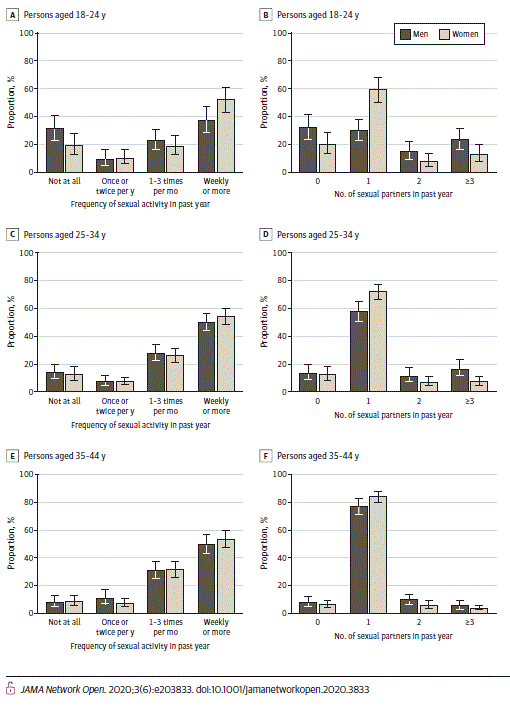
Looking at specific demographic information, more men than women reported having both no sexual partner and three or more partners. Gay and bisexual men were less likely to report having no sexual partners. Black men compared to white men were more likely to indicate three or more sexual partners, as were men and women identifying as gay, lesbian or bisexual. A higher percentage of women reported having only one sexual partner. Men with lower income, part-time employment, and no employment, were less likely to be sexually active compared to men and women with full-time employment. Additionally, both men and women who identified as students were less sexually active.
How do these results compare to previous data? Between 2000-2002 and 2016-2018, the percentage of 18- to 24-year-old men who reported having had no sexual activity in the past year increased, but not for women (Ueda et al., 2020). Less sexual activity was also observed among those aged 25 to 34 years for both men and women, but not among those aged 35 to 44 years. The decrease in sexual activity occurred mainly among unmarried men, as rates of sexual activity were unchanged for unmarried women. Among married men and women, weekly or more sexual frequency decreased for both, regardless of sexual orientation. Instead, married individuals were more likely to engage in sexual activity one to three times per month rather than multiple times per week. Trends in the frequency of sexual activity and number of sexual partners in the past year among US men and women aged 18 to 44 years are shown below.
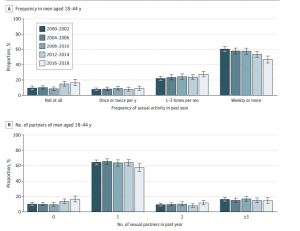
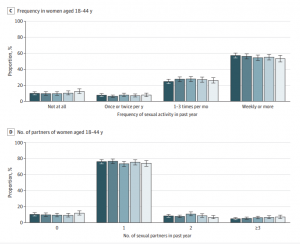
Ueda et al. (2020) proposed several hypotheses for the decrease in sexual activity. These included the stress and busyness of modern life, the supply of online entertainment competing with sexual activity, increased rates of depression and anxiety, adolescents increasingly postponing the start of adult activities, such as dating, and the use of smartphones that decrease opportunities in real-world human interactions. For women, sexual inactivity may be associated with not wanting to engage in the “hooking up” culture, which has generally been reported to be less pleasurable for women, and concern about sexual aggression directed toward them. The authors expressed concern regarding these recent results given that sexual relationships positively correlate with life satisfaction, happiness, lowered heart rate and blood pressure, and stress reduction through the release of oxytocin. Further, a lack of sexual activity has been associated with an increased risk of death, and may be a sign of serious health problems.
Hooking Up
 United States demographic changes have significantly affected the romantic relationships among young adults. The age for puberty has declined, while the times for one’s first marriage and first child have been pushed to older ages. This results in a “historically unprecedented time gap where young adults are physiologically able to reproduce, but not psychologically or socially ready to settle down and begin a family and child rearing,” (Garcia et al., 2012, p. 172). Consequently, according to Bogle (2007, 2008) traditional forms of dating have shifted to more casual hookups that involve uncommitted sexual encounters.
United States demographic changes have significantly affected the romantic relationships among young adults. The age for puberty has declined, while the times for one’s first marriage and first child have been pushed to older ages. This results in a “historically unprecedented time gap where young adults are physiologically able to reproduce, but not psychologically or socially ready to settle down and begin a family and child rearing,” (Garcia et al., 2012, p. 172). Consequently, according to Bogle (2007, 2008) traditional forms of dating have shifted to more casual hookups that involve uncommitted sexual encounters.
Booty calls refer to relationships that are non-committal nor are they expected to be monogamous, but involve repeated sexual encounters (March et al., 2018). They are often thought of as a “compromise” relationship between the genders. The relationship offers sex with lower investment than a committed relationship, which might appeal to males. At the same time has a sense of commitment that is greater than a one-night stand, which might appeal more to females. There is also more emotional expression, such as holding hands and kissing than in one night stands. However, those who engage in booty calls, often do not consider the other party as a friend and thus do not socialize with them. Hookups do not include a friendship relationship.
In contrast, friends with benefits (FWB) are relationships that involve friends having casual sex without commitment. Bisson and Levine (2009) found that 60% of 125 undergraduates reported a FWB relationship. While young adults today do not report more sexual partners, they do report engaging in more casual sex with a friend (Monto & Carey, 2014). The concern with FWB is that one partner may feel more romantically invested than the other (Garcia et al., 2012), and this partner is more likely to be a woman (Williams & Jovanovic, 2015). In their study, Williams and Jovanovic found that men were more likely to report entering into a FWB relationship because it was easier (d=.47), while women were more likely to hope that the relationship might become more (d=-.53). Males also reported more overall satisfaction in FWB relationships (d=.42). However, both men and women were equally satisfied with the sex. This is unlike hookups where women report more pressure to engage in sex, are likely to be more sexually submissive, and report less sexual pleasure (Wade, 2017).
What is the longevity of FWB relationships? Do they become what people want them to be? The answer depends on what the person wants them to be. Machia et al. (2020) sampled over 500 young adults, almost 200 allowed them to reassess their relationships with their FWB partner about a year later. They asked participants at Time 1 what type of relationship were they were hoping this would become: just a friend, a continuation of FWB, a romantic partner, or no relationship. They then assessed at Time 2 what type of relationship were they in with this partner. Those who indicated at Time 1 that they just wanted to be friends, 59% were in such as relationship at Time 2. Those who had indicated that they wished for no relationship, 43% reported this at Time 2. Forty percent of those who had wanted the relationship to stay the same, reported that it was at Time 2. Only 15% of those who had wanted a romantic relationship obtained this. Machia and colleagues report that failure to clearly define what the relationship was and was not, and failure to communicate between the partners what they wanted the relationship to be were big factors in relationships not changing in the direction that people hoped it would.
Hooking up Gender Differences:
When asked about their motivation for hooking up, both males and females indicated physical gratification, emotional gratification, and a desire to initiate a romantic relationship as reasons (Garcia & Reiber, 2008). Although males and females are more similar than different in their sexual behaviors, a consistent finding among the research is that males demonstrate a greater permissiveness to casual sex (Oliver & Hyde, 1993; Hyde, 2014). In another study involving 16,288 individuals across 52 nations, males reported a greater desire of sexual partner variety than females, regardless of relationship status or sexual orientation (Schmitt et al., 2003). This difference can be attributed to gender role expectations for both males and females regarding sexual promiscuity. Additionally, the risks of sexual behavior are higher for females and include unplanned pregnancy, increased sexually transmitted diseases, and susceptibility to sexual violence (Garcia et al., 2012).
In addition among college females, their overabundance on college campuses, 56% of college students in the US are female (Snyder & Dillow, 2015), does not translate into greater sexual power. Males have more power in negotiating partner selection and initiating a relationship, often creating a climate that is more sexually permissive and less beneficial for females (Jenkins Hall & Tanner, 2016). Sutton and Simmons (2014) found that participation in hook-ups was associated by increased sexual victimization by women and perpetration by men. Alcohol use and hook-ups often co-occur (LaBrie et al., 2014).
Although hooking up relationships have become normalized, some research indicates that the majority of men and women would prefer a more traditional romantic relationship (Garcia et al., 2012). Additionally, Owen and Fincham (2011) surveyed 500 college students with experience with hookups, and 65% of women and 45% of men reported that they hoped their hookup encounter would turn into a committed relationship. Further, 51% of women and 42% of men reported that they tried to discuss the possibility of starting a relationship with their hookup partner.
Emotional Consequences of Hooking up:
Concerns regarding hooking up behavior certainly are evident in the research literature. One significant finding is the high comorbidity of hooking up and substance use. Those engaging in non-monogamous sex are more likely to have used marijuana, cocaine, and alcohol, and the overall risks of sexual activity are drastically increased with the addition of alcohol and drugs (Garcia et al., 2012). Regret has also been expressed, and those who had the most regret after hooking up also had more symptoms of depression (Welsh et al., 2006). Hook ups were also found to lower self-esteem, increase guilt, and foster feelings of using someone or feeling used. Females displayed more negative reactions than males. Overall, “the gender gap in hookup regret is mostly a function of gender differences in sexual initiation, sexual agency, sexual enjoyment, loss of respect from one’s partner, and loss of self-respect” (Uecker & Martinez, 2017, p. 470).
Hooking up can best be explained by a biological, psychological, and social perspective. Research indicates that young adults feel it is necessary to engage in hooking up behavior as part of the sexual script depicted in the culture and media. Additionally, they desire sexual gratification. However, they also want a more committed romantic relationship and may feel regret with uncommitted sex.
LGBTQ hookup:
The research on hooking up is decidedly heteronormative, and male focused. Few studies have examined the percentage of LGB adults who hookup and the consequences of such encounters, and even less is known about experiences of transgender young adults (Watson et al., 2017). One of the few studies to examine hookups among sexual minorities reported that 74% of the gay men in their sample, compared to 64% of heterosexual males reported having engaged in a hookup (Barrios & Lundquist, 2012). Gay males also reported having more partners than heterosexual males. This study did not consider women or those who identify as bisexual. Watson et al. (2017) report that the hookup research needs to pay heed to intersectionality, as most of the research focuses on the experiences of college educated White males.
In the next module we will examine interpersonal relationships. We will consider the role of friendship, the lifestyles of singlehood, cohabitation, marriage and divorce, and the role of parenthood and caregiving in the lives of the genders.

